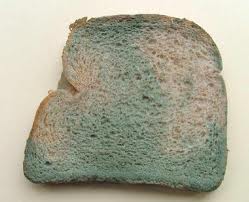Five Most Toxic Types of Mold
What are the 5 MOST TOXIC TYPES of MOLD?
The following molds are capable of Mycotoxin Production:
Stachybotrys
 |
 |
 |
 |
 |
 |
Stachybotrys is the bad boy of them all.
There are some species in the Aspergillus family that are just as toxic as Stachybotrys such as Aspergillus Versicolor and Aspergillus Fumigatus.
The toxins produced can cause diarrhea and upset stomach. It is reported to be a kidney and liver carcinogen.
Aspergillus Fumigatus is one of the most ubiquitous of the airborne saprophytic fungi. Humans and animals constantly inhale numerous conidia of this fungus. However, there has been a dramatic increase in severe and usually fatal invasive aspergillosis, now the most common mold infection worldwide.
But when people talk about toxic black mold, Stachy is the one they’re talking about.
But remember, just because it is black, DOES NOT mean it’s toxic!!
What is Stachybotrys?
Stachybotrys, commonly called “stachy,” is a greenish-black, slimy mold found only on cellulose products (such as wood or paper) that have been wet for several days or more. The mold does not grow on concrete, linoleum or tile.
How is a person exposed to Stachybotrys?
Stachybotrys and some other fungi may produce several toxic chemicals called mycotoxins. Mycotoxins can be present in spores and small mold fragments released into the air. Once the mold fragments, mycotoxins and spores are in the air, individuals may breathe them into their lungs.
What are the symptoms of exposure to Stachybotrys mycotoxins?
Symptoms of exposure to mycotoxins include coughing, wheezing, runny nose, irritated eyes or throat, skin rash and diarrhea.
Since these symptoms are general in nature, they also can be caused by a cold, influenza or exposure to other allergens. It is not known what level of mycotoxin from Stachybotrys must be present in the air to cause these symptoms.
In 1994, the U.S. Centers for Disease Control and Prevention (CDC) investigated whether exposure to Stachybotrys might be related to pulmonary hemorrhage, also known as bleeding lungs, in infants in Cleveland, Ohio. While the CDC initially concluded that there was a possible link between exposure to the mold and the condition, Stachybotrys was not found in the homes of seven children with bleeding lungs identified in the Chicago area between April 1992 and January 1995. A subsequent review of the Cleveland study by a group of CDC experts concluded that a link between exposure to Stachybotrys and bleeding lungs in infants was not proven.
Chaetomium
 |
 |
 |
 |
 |
 |
 |
A vast amount of medical news has been downplayed regarding Chaetomium in the past.
Chaetomiumspp. are among the fungi causing infections wholly refered to as Phaeohyphomycosis.
Fatal deep mycoses due to Chaetomium Atrobrunneum have been documented.
Brain abscess, peritonitis, cutaneous lesions and Onychomycosis may also develop due to exposure.
Unlike most other mold pathogens, there is medical evidence to suggest that people who are exposed to Chaetomium may be predisposed to permanent neurological damage of the myelin sheath. Therefore, a noticeably high incidence of autoimmune diseases have been linked to exposure of this mold such as Multiple Sclerosis, Lupus, etc. It has also been linked to certain forms of Cancer.
As with other fungal exposure, it can also cause permanent DNA damage. This has been documented in several cases being researched during studies. Chaetomium is the only mold that inhibits cell replication.
Chaetomium are found on a variety of substrates containing cellulose including paper and plant compost. Several species have been reported to play a major role in the decomposition of cellulose-made materials. These fungi are able to dissolve the cellulose fibers in cotton and paper and thus cause the materials to disintegrate. The process is especially rapid under moist conditions.
This fungus is reported to be allergenic and a toxin.
On a scale of worst to more mild in effects on human health, contrary to what many believe; Chaetomium would be second or possibly third to Aspergillus only to Stachybotrys
Their Ascospores are brown or gray-olivaceous with one or two germ pores.
Penicillium/Aspergillus
 |
 |
 |
 |
 |
 |
 |
 |
 |
 |
 |
Both of these types of mold are ubiquitous in the environment. Aspergillus tends to colonize continuously damp materials such as damp wallboard and fabrics. Penicillium is commonly found in house dust, wallpaper, decaying fabrics, moist clipboards, etc.
Fusarium
 |
 |
 |
 |
 |
 |
 |
 |
Fusarium is a hydrophilic mold that requires very wet conditions and is frequently isolated from plants and grains. They colonize in continuously damp materials such as damp wallboard and water reservoirs for humidifiers and drip pans.
While Fusarium Keratitis can be a serious infection, it is a rare disease.
Fusarium is commonly found in organic matter such as soil and plants. This infection cannot be transmitted from person to person.
People who have trauma to the eye, certain eye diseases and problems with their immune system may be at increased risk for these types of infection
Ascospores
 |
 |
 |
 |
 |
 |
Ascospores are prominent in nature commonly found in the outdoor environment. Some fungi that belong to the Ascomycete family include the sexual forms of Penicillium/Aspergillus, Chaetominum, etc that may be frequently found growing on damp substrates.







